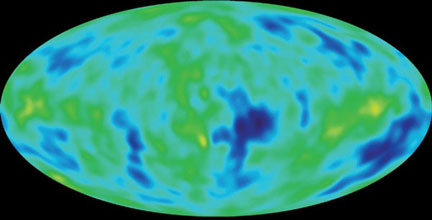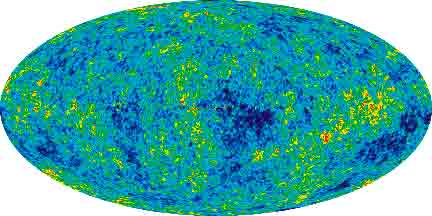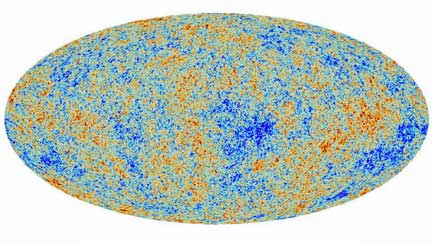Initial
results from the Planck satellite provide superb measurements of the
CMB and refined values of the age and composition of the universe.
The Planck satellite, launched in 2009 by the European Space Agency
(ESA), is the latest effort to understand the beginning of our universe
by studying the Cosmic Microwave Background (CMB).
The CMB is our universe’s “first light” — the first radiation to escape
from the primordial fireball that emerged from the Big Bang. The CMB
that we observe today has been flying through space at the speed of
light for nearly 14 billion years, carrying with it the image of the
most remote reaches of our universe. It shows us what the universe
looked like when it was only 380,000 years old, 36,000 times younger
than it is today.
Back then the universe was a uniform soup of hot hydrogen and helium
gas, without stars, galaxies, or planets. Temperatures and densities
were extremely homogeneous, varying by only 1 part in 100,000. Yet those
minute variations were critical to our future — over the eons, the
slightly denser regions developed into the rich life-enabling structures
we see today.
The following images reveal the advance of science in the last three generations of CMB satellite missions.

CMB image from NASA’s COBE satellite, launched in 1989.

CMB image from NASA’s WMAP satellite, launched in 2001.
 CMB image from ESA’s Planck satellite, launched in 2009. CMB image from ESA’s Planck satellite, launched in 2009.
The
fine details of the CMB are a rich source of cosmic information that
scientists extract using power spectrum analysis. The power spectrum
basically measures “clumpiness” — the power spectrum of an oil painting
reveals what brush sizes the artist used and how often each size was
used. In the Planck power spectrum shown below, each measurement is
represented by a red dot with a vertical line indicating its uncertainty
(the longer the line, the more uncertainty), and the green band
represents the fitted prediction of the Inflationary Big Bang theory.
The match is spectacular.

Combining Planck data with prior measurements, our current best estimates are:
Age of our Universe
13.819±0.058 billion yrs
Current Expansion Rate
46,500±1000 mph per million light-yrs
Percentage of Normal Matter
4.86±0.07%
Percentage of Dark Matter
26.5±0.7%
Percentage of Dark Energy
68.6±2.0%
Amazingly, we now know the age of the universe to better than ½% precision.
The Planck satellite was named in honor of the Nobel Prize winning
German physicist, Max Planck (1858-1947), who originated quantum
mechanics, developed the theory of black body radiation, and was
Einstein’s greatest supporter. The CMB is the most pristine example of
black body radiation ever discovered.
The Planck satellite sampled 9 frequency bands using 22 radio wave
detectors and 52 advanced bolometers produced by NASA-JPL/Caltech, which
ran at just 0.1 degrees above absolute zero temperature (–459.67ºF).
This extended sampling facilitated discriminating point sources, such as
galaxies, from the cosmic background radiation.
The orbits of the WMAP and Planck satellites were particularly
interesting. Both were sent to the second Lagrange point (L2 shown
below) of the Earth-Sun system. At each of five Lagrange points, Earth’s
gravity and the Sun’s gravity combine to yield a quasi-stable orbit
with a period of one Earth year. Satellites near L2 are far enough from
Earth to minimize interference from terrestrial radiation, yet remain
close enough to facilitate communication.
L2 is 1.5 million km (930,000 miles) from Earth in the direction
opposite the Sun. Because orbits at L2 are only quasi-stable, Planck
orbited L2 at an average distance of 400,000 km (250,000 miles).

Having completed its mission in August, the Planck satellite has been sent off into an Earth-avoiding orbit.
Analysis of Planck’s data is far from complete, so we expect further
updates. Of special interest will be Planck’s measurements of the
polarization of CMB light.
Best Regards,
Robert
Note: Previous newsletters can be found on my website.
|